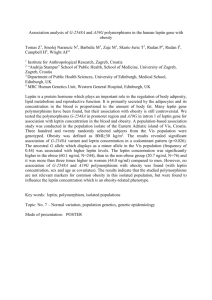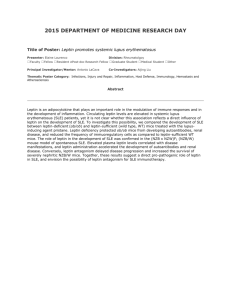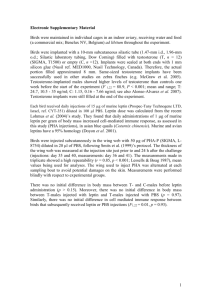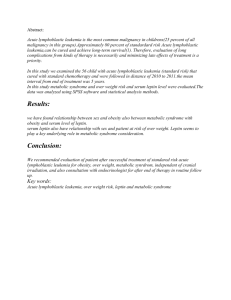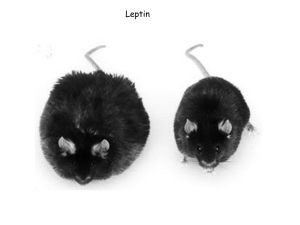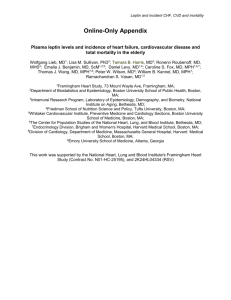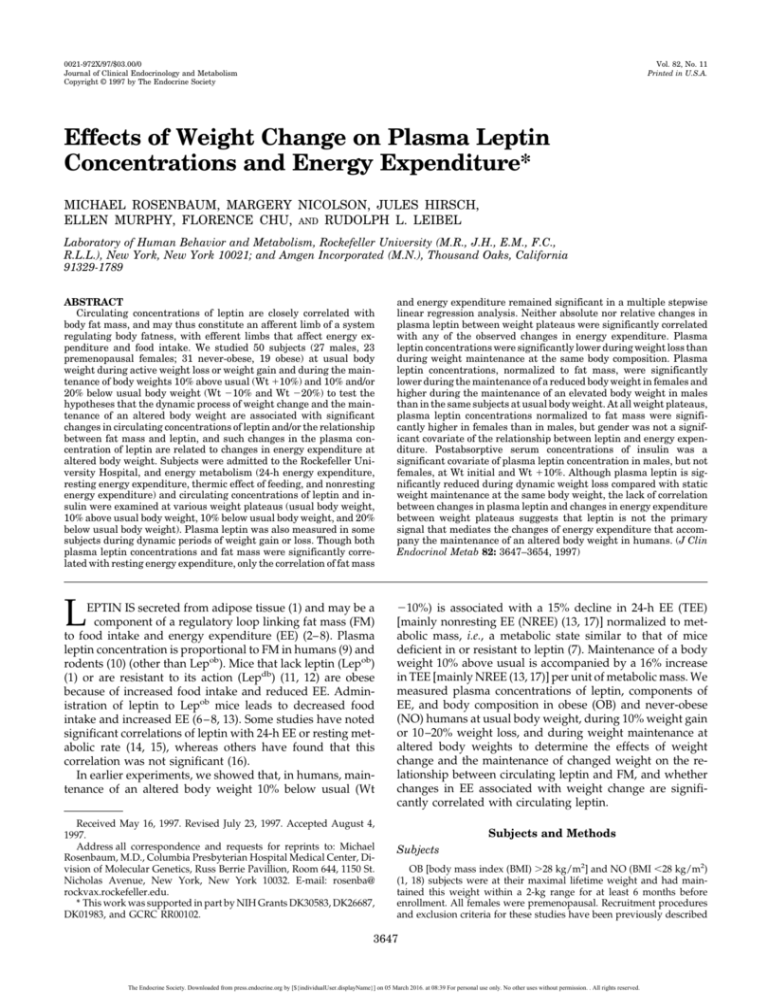
0021-972X/97/$03.00/0
Journal of Clinical Endocrinology and Metabolism
Copyright © 1997 by The Endocrine Society
Vol. 82, No. 11
Printed in U.S.A.
Effects of Weight Change on Plasma Leptin
Concentrations and Energy Expenditure*
MICHAEL ROSENBAUM, MARGERY NICOLSON, JULES HIRSCH,
ELLEN MURPHY, FLORENCE CHU, AND RUDOLPH L. LEIBEL
Laboratory of Human Behavior and Metabolism, Rockefeller University (M.R., J.H., E.M., F.C.,
R.L.L.), New York, New York 10021; and Amgen Incorporated (M.N.), Thousand Oaks, California
91329-1789
ABSTRACT
Circulating concentrations of leptin are closely correlated with
body fat mass, and may thus constitute an afferent limb of a system
regulating body fatness, with efferent limbs that affect energy expenditure and food intake. We studied 50 subjects (27 males, 23
premenopausal females; 31 never-obese, 19 obese) at usual body
weight during active weight loss or weight gain and during the maintenance of body weights 10% above usual (Wt 110%) and 10% and/or
20% below usual body weight (Wt 210% and Wt 220%) to test the
hypotheses that the dynamic process of weight change and the maintenance of an altered body weight are associated with significant
changes in circulating concentrations of leptin and/or the relationship
between fat mass and leptin, and such changes in the plasma concentration of leptin are related to changes in energy expenditure at
altered body weight. Subjects were admitted to the Rockefeller University Hospital, and energy metabolism (24-h energy expenditure,
resting energy expenditure, thermic effect of feeding, and nonresting
energy expenditure) and circulating concentrations of leptin and insulin were examined at various weight plateaus (usual body weight,
10% above usual body weight, 10% below usual body weight, and 20%
below usual body weight). Plasma leptin was also measured in some
subjects during dynamic periods of weight gain or loss. Though both
plasma leptin concentrations and fat mass were significantly correlated with resting energy expenditure, only the correlation of fat mass
and energy expenditure remained significant in a multiple stepwise
linear regression analysis. Neither absolute nor relative changes in
plasma leptin between weight plateaus were significantly correlated
with any of the observed changes in energy expenditure. Plasma
leptin concentrations were significantly lower during weight loss than
during weight maintenance at the same body composition. Plasma
leptin concentrations, normalized to fat mass, were significantly
lower during the maintenance of a reduced body weight in females and
higher during the maintenance of an elevated body weight in males
than in the same subjects at usual body weight. At all weight plateaus,
plasma leptin concentrations normalized to fat mass were significantly higher in females than in males, but gender was not a significant covariate of the relationship between leptin and energy expenditure. Postabsorptive serum concentrations of insulin was a
significant covariate of plasma leptin concentration in males, but not
females, at Wt initial and Wt 110%. Although plasma leptin is significantly reduced during dynamic weight loss compared with static
weight maintenance at the same body weight, the lack of correlation
between changes in plasma leptin and changes in energy expenditure
between weight plateaus suggests that leptin is not the primary
signal that mediates the changes of energy expenditure that accompany the maintenance of an altered body weight in humans. (J Clin
Endocrinol Metab 82: 3647–3654, 1997)
L
210%) is associated with a 15% decline in 24-h EE (TEE)
[mainly nonresting EE (NREE) (13, 17)] normalized to metabolic mass, i.e., a metabolic state similar to that of mice
deficient in or resistant to leptin (7). Maintenance of a body
weight 10% above usual is accompanied by a 16% increase
in TEE [mainly NREE (13, 17)] per unit of metabolic mass. We
measured plasma concentrations of leptin, components of
EE, and body composition in obese (OB) and never-obese
(NO) humans at usual body weight, during 10% weight gain
or 10 –20% weight loss, and during weight maintenance at
altered body weights to determine the effects of weight
change and the maintenance of changed weight on the relationship between circulating leptin and FM, and whether
changes in EE associated with weight change are significantly correlated with circulating leptin.
EPTIN IS secreted from adipose tissue (1) and may be a
component of a regulatory loop linking fat mass (FM)
to food intake and energy expenditure (EE) (2– 8). Plasma
leptin concentration is proportional to FM in humans (9) and
rodents (10) (other than Lepob). Mice that lack leptin (Lepob)
(1) or are resistant to its action (Lepdb) (11, 12) are obese
because of increased food intake and reduced EE. Administration of leptin to Lepob mice leads to decreased food
intake and increased EE (6 – 8, 13). Some studies have noted
significant correlations of leptin with 24-h EE or resting metabolic rate (14, 15), whereas others have found that this
correlation was not significant (16).
In earlier experiments, we showed that, in humans, maintenance of an altered body weight 10% below usual (Wt
Received May 16, 1997. Revised July 23, 1997. Accepted August 4,
1997.
Address all correspondence and requests for reprints to: Michael
Rosenbaum, M.D., Columbia Presbyterian Hospital Medical Center, Division of Molecular Genetics, Russ Berrie Pavillion, Room 644, 1150 St.
Nicholas Avenue, New York, New York 10032. E-mail: rosenba@
rockvax.rockefeller.edu.
* This work was supported in part by NIH Grants DK30583, DK26687,
DK01983, and GCRC RR00102.
Subjects and Methods
Subjects
OB [body mass index (BMI) .28 kg/m2] and NO (BMI ,28 kg/m2)
(1, 18) subjects were at their maximal lifetime weight and had maintained this weight within a 2-kg range for at least 6 months before
enrollment. All females were premenopausal. Recruitment procedures
and exclusion criteria for these studies have been previously described
3647
The Endocrine Society. Downloaded from press.endocrine.org by [${individualUser.displayName}] on 05 March 2016. at 08:39 For personal use only. No other uses without permission. . All rights reserved.
JCE & M • 1997
Vol 82 • No 11
a
P , 0.005 compared with Wt initial (see Subjects and Methods for descriptions of weight plateaus). b P , 0.001 compared with same subjects at Wt initial; c P , 0.01 compared
with same subjects at Wt initial; d P , 0.005 compared with 0; e P , 0.001 compared with 0 and compared with subjects of same gender studied at Wt 210%. Residuals of plasma
leptin concentrations were calculated as difference between actual plasma concentration of leptin at altered weight plateau and plasma leptin concentration predicted from regression
of plasma leptin concentration vs. FM in same subjects at Wt initial.
14.3 6 7.1
17.2 6 6.6
65.1 6 10.7
74.6 6 10.4b
91.7 6 8.5
83.6 6 5.6
9.0 6 4.1
6.6 6 2.2b
54.9 6 11.0
33.3 6 8.2b
82.8 6 7.9
30.6 6 6.8b
0.69 6 0.07
0.87 6 0.10a
0.87 6 0.06
1.00 6 0.07a
0.88 6 0.03
0.84 6 0.04
0.67 6 0.11
0.51 6 0.08a
0.82 6 0.03
0.72 6 0.05a
0.94 6 0.07
0.60 6 0.03a
0.68 6 0.10
0.80 6 0.07a
0.78 6 0.07
0.93 6 0.08a
0.84 6 0.08
0.82 6 0.05
0.72 6 0.15
0.54 6 0.11a
0.74 6 0.08
0.60 6 0.06a
0.91 6 0.09
0.58 6 0.05a
23.8 6 2.1
29.1 6 7.5a
51.7 6 8.3
57.4 6 8.4a
70.5 6 8.2
67.4 6 7.2
26.5 6 4.9
18.3 6 4.3a
42.2 6 8.4
34.2 6 8.2a
68.4 6 7.4
43.0 6 5.7a
63.0 6 3.7
65.8 6 2.5a
52.2 6 3.0
57.1 6 3.8a
59.5 6 2.8
61.4 6 4.3
62.9 6 1.9
60.7 6 1.5a
49.3 6 3.0
47.8 6 3.2a
59.4 6 2.8
52.7 6 3.0a
initial
86.8 6 8.8
110%
95.0 6 9.4a
initial
103.9 6 11.1
110%
114.4 6 11.7a
initial
129.9 6 10.3
initial 2 128.8 6 10.0
initial
89.3 6 6.3
210%
79.1 6 5.4a
initial
91.5 6 11.1
210%
81.9 6 9.7a
initial
127.8 6 9.8
220%
95.7 6 7.3a
Gluteal
Plasma leptin
adipocyte size
(ng/mL)
(mg lipid/cell)
Abdominal
adipocyte size
(mg lipid/cell)
FM
(kg)
Fat-free mass
(kg)
Weight (kg)
Plateau
Subject
characteristics
Wt
Wt
Female (10 OB, 4 NO) Wt
Wt
Wt initial and Wt initial 2 Female (8 OB)
Wt
Wt
Wt initial and Wt 210%
Male (10 NO, 3 OB)
Wt
Wt
Female (7 NO, 7 OB) Wt
Wt
Wt initial and Wt 220%
Female (10 OB)
Wt
Wt
Direct measures of body composition [fat-free mass (FFM), FM, adipocyte volume], indices of body fatness (BMI, percent body fat), or
indices of anatomic distribution of body fat (waist/hip ratio) were related to measures of EE and plasma leptin by linear regression analyses.
FM and plasma concentrations of leptin did not demonstrate a normal
distribution of values and were, therefore, expressed as log FM and log
[leptin], respectively, to normalize data and to avoid any type I statistical
error that might be engendered by a bimodal distribution of values for
a parameter. All significant independent variables were then examined
for interactions among variables, and effects of each variable adjusted
for the effects of all other independent variables by forward stepwise
multiple linear regression analyses against the same dependent variables (23).
Between-group analyses (OB vs. NO, male vs. female) were made by
Plateaus
studied
Statistical analyses
TABLE 1. Body composition and plasma leptin measurements in subjects at different weight plateaus
The protocol for these studies is described in detail elsewhere (13, 17).
Briefly, subjects were admitted to the Clinical Research Center at Rockefeller University, and allowed ad libitum physical activity. They were
fed a liquid formula diet plus vitamin and mineral supplements. Daily
formula intake was adjusted until weight stability (defined as a slope of
,0.01 kg/day in a 14-day plot of weight vs. days) was achieved. We have
reported previously that 24-h EE (TEE) calculated by this method is
highly correlated (r2 5 0.88, P , 0.0001) with direct measurement of TEE
by doubly labeled water (17). At this point, the following metabolic tests
were conducted over a period of approximately 14 days (13, 17). 1)
Resting EE (REE) and the thermic effect of feeding (TEF) by indirect
calorimetry (19). NREE was calculated as NREE 5 TEE 2 (REE 1 TEF).
2) Body composition analysis by hydrodensitometry (20). 3) Measurement of the waist circumference at a point one third of the distance from
the xiphoid process to the umbilicus and the hip circumference at the
head of the superior margin of the pubic bone (21). 4) Postabsorptive
plasma leptin concentrations were assayed by a solid-phase sandwich
enzyme immunoassay using an affinity-purified polyvalent antibody
immobilized in microliter wells. Bound leptin was detected with affinity
purified antibody conjugated to horseradish peroxidase, and quantified
with a chromogenic substrate (3,39,5,59 tetramethylbenzidine/peroxide).
Leptin concentrations were calculated from standard curves generated
for each assay using recombinant human leptin. Minimal detectable
leptin is 20 pg/mL. All samples from any individual subject were analyzed in the same assay (9). 5) Abdominal and gluteal subcutaneous
adipose tissue aspirations were performed under local anesthesia with
1% xylocaine. Adipocyte volumes (micrograms lipid/cell) were determined by the osmium fixation method. The intraassay variability of this
method is ,3% (22). Postabsorptive serum insulin concentrations were
measured by RIA immediately before performance of these biopsies.
Following completion of studies at usual body weight (Wt initial),
subjects were either provided maximum tolerated intake of mixed solid
self-selected foods (generally 5000 – 8000 kcal/day) until they had
gained 10% (Wt 110%) of Wt initial or were placed on 800 kcal/day of
the liquid formula diet until they had lost 10% (Wt 210%) or 20% (Wt
220%) of Wt initial. Some subjects were studied at multiple weight
plateaus, and eight OB women who had completed studies at Wt initial
and Wt 110% were fed 800 kcal/day of the liquid formula diet until
body weight was reduced to their usual weight (Wt initial 2). At each
new weight plateau (Wt 110%, Wt initial2, Wt 210%, or Wt 220%)
weight was again maintained as described above and, when weight was
stable for at least 14 days, the studies described above were repeated.
Plasma leptin was also measured in the postabsorptive state at the end
of each period of weight loss or gain, when the intended new level of
weight had been achieved (10% above or 10% below Wt initial) but the
subject was still gaining or losing weight. This was done to assess
possible effects on plasma leptin of dynamic weight loss or gain vs. static
weight maintenance at the same body weight. Subject characteristics at
each plateau are indicated in Table 2.
Plasma
leptin/FM
(ng/mL/kg)
Experimental design
Male (14 NO, 3 OB)
Residual
plasma leptin
(ng/mL)
(13). All studies were approved by the Institutional Review Board of the
Rockefeller University Hospital, and written informed consent was obtained from all subjects before enrollment. Subject characteristics are
presented in Table 1.
0.3 6 0.1
0.4 6 0.1c
2.2 6 2.2
1.2 6 0.1
1.4 6 0.1
3.1 6 5.1
1.4 6 0.1
1.3 6 0.1
25.2 6 5.1
0.4 6 0.1
0.3 6 0.1
0.2 6 2.1
1.3 6 0.1
0.8 6 0.1c 210.4 6 2.7d
1.3 6 0.13
0.7 6 0.16a 231.3 6 4.6e
ROSENBAUM ET AL.
Wt initial and Wt 110%
3648
The Endocrine Society. Downloaded from press.endocrine.org by [${individualUser.displayName}] on 05 March 2016. at 08:39 For personal use only. No other uses without permission. . All rights reserved.
EFFECT OF WEIGHT CHANGE ON LEPTIN AND ENERGY
3649
TABLE 2. Measures of body composition and plasma leptin in subjects matched by FM
Plateaus studied
Wt initial
Wt initial and Wt 110%
Gender
Male
Female
Male
Female
Wt initial and Wt 210%
Male
Female
Somatotypes
FFM
(kg)
FM
(kg)
Postabsorptive
plasma (insulin)
(mU/mL)
Plasma leptin
(ng/mL)
Plasma
leptin/FM
(ng/mL/kg)
7 NO, 2 NO
6 NO, 3 OB
9 NO
9 NO
1 OB, 3 NO
1 OB, 3 NO
7 NO
7 NO
6 NO, 6 OB
5 NO, 7 OB
65.6 6 3.5
47.4 6 2.5a
58.2 6 1.7
59.6 6 1.7
50.9 6 5.5
49.4 6 4.1
61.4 6 1.9
60.7 6 1.8
47.2 6 3.1
49.3 6 3.4
32.5 6 9.5
32.7 6 9.6
14.3 6 1.2
14.3 6 1.2
43.9 6 11.6
43.7 6 11.5
12.2 6 1.1
12.1 6 1.1
33.8 6 6.4
33.8 6 6.3
32.2 6 4.4
29.5 6 3.6
29.1 6 2.6
36.4 6 2.8c
18.2 6 5.5
23.2 6 3.7
14.2 6 2.9
9.6 6 3.1
23.6 6 4.3
13.8 6 1.2c
22.3 6 9.90
38.9 6 12.1a
3.4 6 1.0
6.6 6 1.6b
75.5 6 19.5
60.9 6 17.8
2.7 6 0.9
2.4 6 1.0
41.2 6 8.2
26.9 6 6.8b
0.5 6 0.1
1.1 6 0.1a
0.2 6 0.1
0.4 6 0.1b
1.7 6 0.2
1.4 6 0.3
0.3 6 0.1
0.3 6 0.1
1.2 6 0.1
0.7 6 0.1b
Plateau
Wt
Wt
Wt
Wt
Wt
Wt
Wt
Wt
Wt
Wt
initial
initial
initial
110%
initial
110%
initial
210%
initial
210%
Mean 6 SEM. a P , 0.005 compared with FM males at Wt initial; b P , 0.005 compared with subjects at Wt initial; c P , 0.01 compared with
subjects at Wt initial. Note that both FM and FFM are matched in subjects of same gender studied at multiple weight plateaus.
TABLE 3. Serum insulin following overnight fast (postabsorptive), plasma leptin, and FM
Plateaus studied
Wt initial
Wt initial and Wt 110%
Gender
Male
Female
Male
Female
Wt initial and Wt 210%
Male
Female
Wt 220%
Mean 6
Female
SEM.
a
Plateau
Wt
Wt
Wt
Wt
Wt
Wt
Wt
Wt
Wt
Wt
Wt
Wt
Somatotypes
initial
initial
initial
110%
initial
110%
initial
210%
initial
210%
initial
220%
P , 0.005 compared with males;
13 NO, 6 OB
7 NO, 11 OB
10 NO, 2 OB
4 NO, 9 OB
4 NO, 3 OB
4 NO, 7 OB
8 OB
b
Postabsorptive
plasma (insulin)
(mU/mL)
FM (kg)
Plasma leptin
(ng/mL)
Plasma leptin/kg FM
(ng/mL/kg)
27.2 6 4.4
27.9 6 4.6
24.6 6 5.3
43.8 6 8.4b
27.8 6 6.0
41.6 6 9.2b
30.2 6 5.5
38.3 6 6.6
25.0 6 3.3
19.9 6 3.7
25.9 6 5.5
17.8 6 2.6b
22.6 6 3.4
48.7 6 7.6a
21.0 6 6.9
25.6 6 6.7b
54.4 6 8.5
63.2 6 9.1
32.7 6 10.2
24.9 6 8.6b
49.9 6 9.4
40.4 6 7.5b
68.5 6 8.4
42.8 6 7.4b
11.6 6 5.0
59.9 6 9.2a
10.2 6 5.7
13.8 6 6.4
69.6 6 8.5
75.7 6 10.5
18.1 6 8.3
8.3 6 3.8b
65.0 6 12.3
40.4 6 9.4b
84.7 6 8.7
25.7 6 7.9b
0.3 6 0.1
1.2 6 0.1a
0.3 6 0.1
0.3 6 0.1
1.3 6 0.1
1.4 6 0.1
0.4 6 0.1
0.3 6 0.1
1.3 6 0.1
0.9 6 0.1b
1.3 6 0.1
0.7 6 0.1b
P , 0.005 compared with same subjects at Wt initial.
one-way ANOVA. Between-group analyses to determine whether initial
somatotype (OB, NO), gender, or weight plateau altered the relationship
between plasma leptin and measures of body composition were made
by analysis of covariance using the grouping variable as a covariate.
Within-group analyses, i.e. the same measures at initial weight vs. altered
weight plateaus, were performed using ANOVA with repeated measures (23).
Regression equations relating EE and plasma leptin to FM and/or
FFM, do not necessarily have Y-axis intercepts 5 0 (Table 1) (13, 17, 24).
Therefore, in addition to expressing EE as kcal/kg FFM, regression
equations of EE vs. FFM and FM, and plasma leptin vs. FM at usual (Wt
initial) body weight were used to calculate residuals (actual EE minus
predicted EE based on the regression line at Wt initial) of the same
subjects at other weight plateaus. Residuals were then tested against the
null hypothesis that residual 5 0. For all statistical analyses, statistical
significance was defined as Pa , 0.05.
Results
EE and body composition
As reported previously (13), there were significant increases at Wt 1 10% in TEE (16.5 6 1.8%, P , 0.001) and
NREE (36.8 6 5.9, P , 0.001) adjusted for FFM and in TEF
expressed as a percentage of ingested calories (3.0 6 1.6% at
Wt initial vs. 5.1 6 2.0% at Wt 110%, P , 0.01) were significantly increased at Wt 110%. At Wt 210% and Wt 220%,
TEE (216.2 6 1.4% at Wt 210%; 228.5 6 3.8% at Wt 2; both
P , 0.001), REE (210.8 6 2.3% at Wt 210%; 220.7 6 5.4%
at Wt 220%; both P , 0.001), and NREE (229.4 6 6.2% at Wt
210%; 235.8 6 8.7% at Wt 220%; both P , 0.001) adjusted
for FFM were significantly decreased. Weight gain and loss
were associated with respective significant increases and
decreases in both FFM and FM. No significant effects of
gender, initial somatotype, or weight gain followed by return
to initial weight (Wt initial 2) on any of these variables were
noted (Table 1).
Body composition and biochemical correlates of plasma
concentrations of leptin
Plasma leptin concentration was significantly correlated
with FM in all subjects at all weight plateaus (P , 0.0001, Fig.
1). Plasma leptin concentrations were significantly higher in
females than in males, corrected for FM, at all weight plateaus (P , 0.0001) (9). No significant correlations were noted
between plasma leptin and age, FFM, or any index of body
fatness (percent body fat, BMI, or initial somatotype) once
adjusted for the effects of FM in males or females. In multiple
stepwise regression analyses of males and females in which
FM, FFM, and gender were included as independent variables, only gender and FM were significant covariates of
plasma leptin concentrations. In stepwise multiple regression analyses, both FM and postabsorptive plasma concentrations of insulin (Table 3) were significantly correlated with
plasma leptin in males at Wt initial (Plasma [leptin] 5
0.75(FM)] 1 0.16(postabsorptive [insulin] 2 9.7; Radj. 5 0.99,
p-FM , 0.0001, p-insulin , 0.05) and Wt 110% (Plasma
[leptin] 5 0.74(FM)] 1 0.28(postabsorptive [insulin] 2 17.2;
Radj. 5 0.95, p-FM , 0.0001, p-insulin , 0.0005). No signif-
The Endocrine Society. Downloaded from press.endocrine.org by [${individualUser.displayName}] on 05 March 2016. at 08:39 For personal use only. No other uses without permission. . All rights reserved.
3650
ROSENBAUM ET AL.
JCE & M • 1997
Vol 82 • No 11
icant correlations between plasma leptin and postabsorptive
insulin concentrations were found in females at any weight
plateau. Neither abdominal nor gluteal fat cell size, nor any
measures of body fat distribution (waist or hip circumference, waist/hip ratio; abdominal or gluteal fat cell size, or
abdominal/gluteal fat cell size ratio) were significantly correlated with plasma leptin once corrected for the effects of
FM.
Plasma concentrations of leptin and changes in body
composition
Maintenance of a reduced body weight was associated
with a significant reduction in plasma leptin concentration/FM only in females (Fig. 1 and Table 1). Similarly,
females studied at reduced body weight had significantly
lower plasma concentrations of leptin than body composition-matched females studied at Wt initial (Table 2 and Fig.
2). This effect was not because of the non-zero Y-axis intercept of the regression line relating FM to leptin, because
residual values of leptin in weight-reduced females (calculated as actual minus predicted values based on the regression of plasma leptin on FM at Wt initial) were significantly
less than zero. Residual values of plasma leptin at Wt 220%
in females were significantly lower than values for female
subjects at Wt 210%.
In contrast, maintenance of an elevated body weight was
associated with a significant increase in plasma leptin/FM
only in males (Fig. 1 and Table 1). Similarly, males studied
at elevated body weight had significantly higher plasma
concentrations of leptin than body composition-matched
males studied at Wt initial (Table 2 and Fig. 2). Because
postabsorptive insulin concentration was a significant covariate of plasma leptin in males at Wt initial and at Wt
110%, and weight maintenance at Wt 110% was associated
with a significant increase in postabsorptive plasma concentration of insulin in males, but not females (see above), we
corrected the calculation of weight plateau effects on plasma
leptin concentrations for the effects of insulin by ANCOVA.
Plasma leptin/FM was not significantly increased over Wt
initial in males at Wt 110% once corrected for the effects of
the increased postabsorptive serum insulin concentrations.
FIG. 1. Regressions of log plasma leptin (nanograms per milliliter) vs.
log FM (kilograms). No significant differences were noted between
regression lines generated independently for NO (BMI ,27 kg/m2)
and OB (BMI .27 kg/m2) subjects; therefore, these groups are presented together. Regression equations at Wt initial were log [leptin]
5 1.03(log FM) 10.02 in females and log [leptin] 5 1.76(log FM) 21.6
in males. A, Leptin concentrations were significantly greater per unit
of FM in females (▫, continuous line) compared with males (n, broken
line) during weight maintenance at Wt initial. B, Leptin concentrations corrected for FM were significantly reduced in females during
weight maintenance at Wt 210% (Œ, log [leptin] 5 1.23(log FM)
20.40), Wt 220% (l, log [leptin] 5 1.50(log FM) 20.99), but not
significantly changed at Wt 110% (‚, log [leptin] 5 0.72(log FM)
10.62) compared with regression line for females depicted in Fig. 2A.
C, Leptin concentrations corrected for FM were significantly increased in males during weight maintenance at Wt 110% (E, log
[leptin] 5 1.40(log FM) 20.99) but not significantly changed at Wt
210% (F, log [leptin] 5 1.04(log FM) 11.40) compared with regression
line for males depicted in Fig. 2A.
The Endocrine Society. Downloaded from press.endocrine.org by [${individualUser.displayName}] on 05 March 2016. at 08:39 For personal use only. No other uses without permission. . All rights reserved.
EFFECT OF WEIGHT CHANGE ON LEPTIN AND ENERGY
The process of dynamic weight loss, but not gain, was
associated with a significant change (decrease) in plasma
leptin/FM compared with the same subjects during maintenance at the same weight (Table 4). This effect was evident
in all subjects. However, correlation coefficients between
plasma leptin and FM were not significantly different between subjects studied during dynamic weight change and
during weight maintenance at the same weight, i.e. circulating leptin concentration was still significantly correlated
with FM during dynamic weight change. Eight females were
studied at the end of dynamic weight loss from Wt 110%
back to Wt initial, and during maintenance at usual body
weight (Wt initial 2). Postabsorptive plasma concentrations
of insulin during weight loss (16.8 6 3.8 mU/mL) were significantly lower than postabsorptive plasma insulin concentrations obtained during weight maintenance at Wt initial 2
(22.9 6 3.8 mU/mL, P , 0.01). Plasma leptin during weight
loss remained significantly lower (P , 0.005) than plasma
leptin at Wt initial2 even when corrected for postabsorptive
plasma insulin concentrations. No significant differences between plasma leptin at Wt initial and Wt initial 2 were noted,
again providing evidence that there is no carry over effect of
the reduction in plasma leptin during weight loss from Wt
110% to Wt initial 2 on plasma leptin during weight
maintenance.
FIG. 2. Histogram showing mean 6 SE plasma leptin concentrations
in subjects matched for FM but differing in gender or weight plateau
at which plasma leptin concentration was measured. Body composition data are given in Table 2. *, P , 0.005 compared with males
matched for FM; **, P , 0.01 compared with females matched for FM
at Wt initial.
3651
Plasma concentrations of leptin and EE
Plasma concentrations of leptin and FM were significantly
correlated with REE and TEE at all weight plateaus. Despite
the visual similarity between regressions relating EE to FM
and leptin (Fig. 3) following multiple stepwise linear regression analysis to adjust for the significant colinearity of FFM,
FM, and plasma leptin, only FFM and FM remained significantly correlated with REE (Table 5). No significant correlations were noted between changes in plasma leptin, plasma
leptin/FM, or residual values of plasma leptin and changes
in any measure of EE (whether expressed as changes in
kilocalories per kilogram FFM or as residual values) between
weight plateaus in any group. Therefore, though plasma
leptin/FM did decline significantly in females following
weight loss, and did increase significantly in males following
weight gain, the degree to which these increases occurred did
not correlate with the degree to which EE was decreased or
increased following weight loss or weight gain, respectively.
Discussion
The most important findings reported here regarding leptin and it’s possible role in energy homeostasis are the following. 1) Once corrected for body composition, in all groups
and at all weight plateaus, plasma leptin does not correlate
significantly with measures of EE in weight-stable OB and
NO human subjects. 2) Dynamic weight loss is associated
with a significant decline in plasma leptin corrected for FM,
independent of changes in postabsorptive plasma insulin
concentrations. 3) In females, maintenance of a reduced body
weight is associated with a significant decline in plasma
leptin corrected for FM independent of changes in postabsorptive plasma insulin concentrations. 4) In males, maintenance of an elevated body weight is associated with increased plasma leptin concentrations corrected for FM,
perhaps because of insulin-mediated effects. 5) Weight gainor loss-associated changes in plasma leptin are not significantly correlated with weight gain- or loss-associated
changes in any measured component of EE.
In weight-stable OB and NO humans, the circulating concentration of leptin is determined primarily by gender and
by FM (9). The observation that plasma leptin was significantly decreased during dynamic weight loss compared with
levels in the same subjects at the same weight during static
weight maintenance indicates that plasma leptin concentration is influenced by intercurrent metabolic factors in addition to FM, in agreement with other studies in humans (25)
and in rodents (26, 27). Insulin has been shown to increase
leptin gene expression in adipose tissue (28, 29), and inclu-
TABLE 4. Plasma leptin concentration during dynamic weight change and static maintenance at same weight
Weight gain to Wt 110%
Wt 110%
Weight loss to Wt initial 2
Wt initial 2
Weight loss to Wt 210%
Wt 210%
Weight loss to Wt 220%
Wt 220%
a
Subjects
Plasma leptin (ng/mL)
4 Males (2 NO, 2 OB)
9 Females (1 NO, 8 OB)
8 OB Females
82.9 6 11.4
81.1 6 10.7
48.1 6 7.9a
82.7 6 6.4
23.2 6 3.8a
45.4 6 9.2
17.7 6 4.4a
29.6 6 6.4
3 Males (1 NO, 2 OB),
7 Females (7 OB)
2 OB Males,
9 OB Females
P , 0.005 compared with same subjects at same weight but during weight maintenance.
The Endocrine Society. Downloaded from press.endocrine.org by [${individualUser.displayName}] on 05 March 2016. at 08:39 For personal use only. No other uses without permission. . All rights reserved.
3652
ROSENBAUM ET AL.
JCE & M • 1997
Vol 82 • No 11
FIG. 3. Log [leptin] (A) and log FM (B)
vs. REE (l; n) and TEE (L; ▫) normalized to FFM at Wt initial in females (l;
L) and males (n; ▫).
sion of insulin as a covariate in the analysis of the effects of
weight gain on plasma leptin removes the significant differences in plasma leptin concentration in males who have
gained weight (compared with FM-matched males at Wt
initial). In contrast, plasma leptin concentration is not significantly different between females at Wt 110% and FMmatched females at Wt initial, despite the fact that postabsorptive insulin is significantly higher in the women at Wt
110%. However, plasma leptin concentrations in females
were significantly decreased during weight loss (relative to
concentrations during maintenance of the same body
weight) and during weight maintenance of a reduced body
weight (relative to Wt initial), even when the regression of
plasma leptin vs. FM was statistically corrected for changes
in postabsorptive plasma insulin concentrations.
Intracerebroventricular or intraperitoneal leptin adminis-
The Endocrine Society. Downloaded from press.endocrine.org by [${individualUser.displayName}] on 05 March 2016. at 08:39 For personal use only. No other uses without permission. . All rights reserved.
EFFECT OF WEIGHT CHANGE ON LEPTIN AND ENERGY
3653
TABLE 5. Regression equations, partial correlation coefficients, and P values relating REE and TEE to body composition, gender, and
plasma concentrations of leptin
Dependent
variable
Wt initial (n 5 50)
Partial r
REE
TEE
Partial r
Wt 210% (n 5 27)
Partial R
REE
TEE
Partial r
Wt 110% (n 5 22)
Partial r
REE
TEE
Partial r
Independent Variables
Gender
FFM (kg)
log [leptin] (ng/mL)
Log FM (kg)
87 (gender)
0.10 (P 5 0.51)
291 (gender)
0.24 (P 5 0.10)
98 (gender)
0.10 (P 5 0.61)
164 (gender)
0.19 (P 5 0.37)
231 (gender)
20.02 (P 5 0.91)
289 (gender)
20.05 (P 1 0.77)
127 (FFM)
0.64 (P , 0.0001)
146 (FFM)
0.72 (P , 0.0001)
129 (FFM)
0.66 (P ,0.0005)
142 (FFM)
0.80 (P , 0.0001)
119 (FFM)
0.42 (P 5 0.03)
144 (FFM)
0.70 (P , 0.0001)
1 3 (log [leptin])
0.004 (P 5 0.98)
2229 (log [leptin])
20.20 (P 5 0.18)
2140 (log [leptin])
20.15 (P 5 0.48)
270 (log [leptin])
20.08 (P 5 0.71)
192 (log [leptin])
0.06 (P 5 0.78)
1357 (log [leptin])
0.12 (P 5 0.56)
1606 (log FM)
0.35 (P 5 0.015)
1804 (log FM)
0.36 (P 5 0.014)
1490 (log FM)
0.34 (P 5 0.1)
1297 (log FM)
0.23 (P 5 0.29)
1440 (log FM)
0.20 (P 5 0.34)
1528 (log FM)
0.19 (P 5 0.35)
Intercept
Adjusted r2
2723
0.85 (P , 0.0001)
2857
0.85 (P , 0.0001)
2646
0.77 (P , 0.0001)
2505
0.85 (P , 0.0001)
230
0.56 (P , 0.0005)
2171
0.80 (P , 0.0001)
Gender was treated as a discontinuous variable (male 5 0, female 5 1).
tration to Lepob mice or intraperitoneal administration of
leptin to non-OB animals at very high doses reduces food
intake and increases EE, resulting in reduced body fat (6 – 8,
30). Intraperitoneal administration of leptin to mice during
starvation rectifies many of the neuroendocrine changes that
occur as a result of food deprivation (31), but does not significantly alter the rate of weight loss. We examined the
correlations of changes in plasma leptin with changes in EE
that occur following weight gain or loss. The lack of correlations between weight loss- or gain-associated changes in
plasma leptin and EE that occur as a result of altered body
weight, and the observation that there is a sexual dimorphism in the weight gain- or loss-associated increases or
decreases in the plasma concentrations of leptin adjusted for
body composition but there are no gender differences in the
changes in EE following weight gain or loss (13, 17), suggest
that leptin is not providing the primary signal mediating
these changes in energy homeostasis in human beings. The
striking correlation of leptin with FM in weight-stable OB
and lean subjects, the reduction of leptin/FM with hypocaloric intake, and the absence of any correlation of leptin with
EE in the weight-stable state are consistent with the hypothesis that leptin may have a primary physiological role as an
emergency signal for depletion of energy stores rather than
as a regulator (suppressor) of body fat, per se. Accordingly,
depletion of adipose tissue mass, or reduction in energy
intake, reduces leptin, evoking compensatory changes in
hunger (increased), EE (decreased), and reproductive function (reduced fertility) (32). Once circulating brain leptin
exceeds a threshold, the behavioral/metabolic stigmata of
fasting are relieved. This model predicts that exogenous leptin might have some clinical utility in facilitating compliance
with a hypocaloric diet and in maintenance of a reduced
body weight. Genetic/developmental factors may influence
the leptin-mediated stimulus strength (and hence degree of
adiposity) required to turn off a metabolic and behavioral
sense of deprivation mediated by ambient leptin concentrations.
Acknowledgments
We would like to gratefully acknowledge the many individuals who
assisted in the completion of this project. In particular, Rachel Kolb,
Eileen Mullen, Jennifer Ziedonis, Alice Murphy, David Markel, Cynthia
Seidman, and the nursing and dietary staff of the Clinical Research
Center at Rockefeller University; Dr. Xavier Pi-Sunyer, Dr. Steven
Heymsfield, and Yim Dam at St. Luke’s/Roosevelt Hospital Medical
Center; and Jason Moore and Andrew Morawiecki at Amgen Inc. We
would also like to thank Dr. Monnie Magee-Harper at the Rockefeller
University Hospital and Mr. Donald J. McMahon at the Irving Center for
Clinical Research at Columbia University College of Physicians and
Surgeons for their assistance in the biostatistical analyses of these data.
References
1. Zhang Y, Proenca R, Maffei M, et al. 1994 Positional cloning of the mouse
obese gene and its human homologue. Nature. 372:425– 432.
2. Neumann R. 1902 Experimentelle Beitrage zur Lehre von dem taglichen
Nahrungsbedarf des Menschen unter besonder Berucksichtigung der notwendigen Eiweifsmenge. Arch Hyg. 45:1– 87.
3. Kennedy G. 1953 The role of depot fat in the hypothalamic control of food
intake in the rat. Proc R Soc Lond [B]. 140:578 –591.
4. Hervey G. 1969 Regulation of energy balance. Nature. 222:629 – 631.
5. Leibel R. 1977 A biologic radar system for the assessment of body mass: the
model of a geometry sensitive endocrine system is presented. J Theor Biol.
66:297–306.
6. Campfield L, Smith F, Guisez Y, et al. 1995 Recombinant mouse OB protein:
evidence for a peripheral signal linking adiposity and central neural networks.
Science. 269:546 –548.
7. Pellymounter M, Cullen M, Baker M, et al. 1995 Effects of the obese gene
product on body weight regulation in ob/ob mice. Science. 269:540 –543.
8. Halaas J, Gajiwala K, Maffei M, et al. 1995 Weight reducing effects of the
plasma protein encoded by the ob gene. Science. 269:543–546.
9. Rosenbaum M, Nicolson M, Hirsch J, et al. 1996 Effects of gender, body
composition, and menopause on plasma concentrations of leptin. J Clin Endocrinol Metab. 81:3424 –3427.
10. Frederich R, Hamann A, Anderson S, et al. 1995 Leptin levels reflect body lipid
content in mice: evidence for diet-induced resistance to leptin action. Nature
Med. 1:1311–1314.
11. Chua S, Chung W, Wu-Peng S, et al. 1996 Phenotypes of mouse diabetes, and
rat fatty due to mutations in the OB (leptin) receptor. Science. 271:994 –996.
12. Tartaglia L, Dembski M, Weng X, et al. 1995 Identification and cloning of a
leptin receptor, OB-r. Cell. 83:1263–1271.
13. Leibel R, Rosenbaum M, Hirsch J. 1995 Changes in energy expenditure
resulting from altered body weight. N Engl J Med. 332:621– 628.
14. Salbe A, Nicolson M, Ravussin E. 1997 Total energy expenditure and physical
activity correlate with plasma leptin concentrations in five-year-old children.
J Clin Invest. 99:592–595.
15. Toth M, Gottlieb S, Fisher M, et al. 1997 Plasma leptin concentrations and
energy expenditure in heart failure patients. Metabolism. 46:450 – 453.
16. Kennedy A, Gettys T, Watson P, et al. 1997 The metabolic significance of leptin
in humans: gender-based differences in relationship to adiposity, insulinsensitivity, and energy expenditure. J Clin Endocrinol Metab. 82:1293–1300.
17. Rosenbaum M, Ravussin E, Matthews D, et al. 1996 A comparative study of
different means of assessing long-term energy expenditure in humans. Am J
Physiol. 270:R496 –R504.
18. Najjar M, Rowland M. 1987 Anthropometric reference data and prevalence of
overweight. National Center for Health Statistics Series 11, No. 238. Department of Health and Human Services publication (Public Health Service)
87–1688.
The Endocrine Society. Downloaded from press.endocrine.org by [${individualUser.displayName}] on 05 March 2016. at 08:39 For personal use only. No other uses without permission. . All rights reserved.
3654
ROSENBAUM ET AL.
19. Ferrannini E. 1988 The theoretical basis of indirect calorimetry: a review.
Metabolism. 37:287–301.
20. Heymsfield S, Wang J, Kehayias J, Itallie TV. 1989 Chemical determination
of human body density in vivo: relevance to hydrodensitometry. Am J Clin
Nutr. 50:1282–1287.
21. Presta E, Leibel R, Hirsch J. 1990 Regional changes in adrenoreceptor status
during hypocaloric intake do not predict changes in adipocyte size or body
shape. Metabolism. 39:307–315.
22. Hirsch J, Gallian E. 1968 Methods for the determination of adipose cell size
in man and animals. J Lipid Res. 9:110 –119.
23. Prophet user manual: release 42. 1994 Cambridge, MA: Bolt, Belanck, and
Newman; 297–319.
24. Ravussin E, Lillioja S, Anderson T, et al. 1986 Determinants of 24-hour energy
expenditure in man. Methods and results using a respiratory chamber. J Clin
Invest. 78:1568 –1578.
25. Weigle D, Duell P, Connor W, et al. 1997 Effect of fasting, refeeding, and
dietary fat restriction on plasma leptin levels. J Clin Endocrinol Metab.
82:561–565.
JCE & M • 1997
Vol 82 • No 11
26. Maffei M, Halaas J, Ravussin E, et al. 1996 Leptin levels in human and rodent:
measurement of plasma leptin and ob RNA in obese and weight-reduced
subjects. Nature Med. 1:1155–1161.
27. Weigle D, Bukowski T, Foster D, et al. 1995 Recombinant ob protein reduces
feeding and body weight in ob/ob mouse. J Clin Invest. 96:2065–2070.
28. McDougald O, Hwang C, Fan H, Lane M. 1995 Regulated expression of the
ob gene product (leptin) in white adipose tissue and 3T3–L1 adipocytes. Proc
Natl Acad Sci USA. 92:9034 –9037.
29. Saladin R, Vos PD, Guerre-DeMillo M, et al. 1995 Transient increase in ob
gene expression after food intake or insulin administration. Nature.
377:577–579.
30. Collins S, Kuhn C, Petro A, et al. 1996 Role of leptin in fat regulation. Nature.
380:677.
31. Ahima R, Prabakaran D, Mantzoros C, et al. 1996 Role of leptin in the
neuroendocrine response to fasting. Nature. 362:250 –252.
32. Chehab F, Lim M, Lu R. 1996 Correction of the sterility defect in homozygous
obese female mice by treatment with recombinant human leptin. Nature
Genet. 12:318 –320.
The Endocrine Society. Downloaded from press.endocrine.org by [${individualUser.displayName}] on 05 March 2016. at 08:39 For personal use only. No other uses without permission. . All rights reserved.

